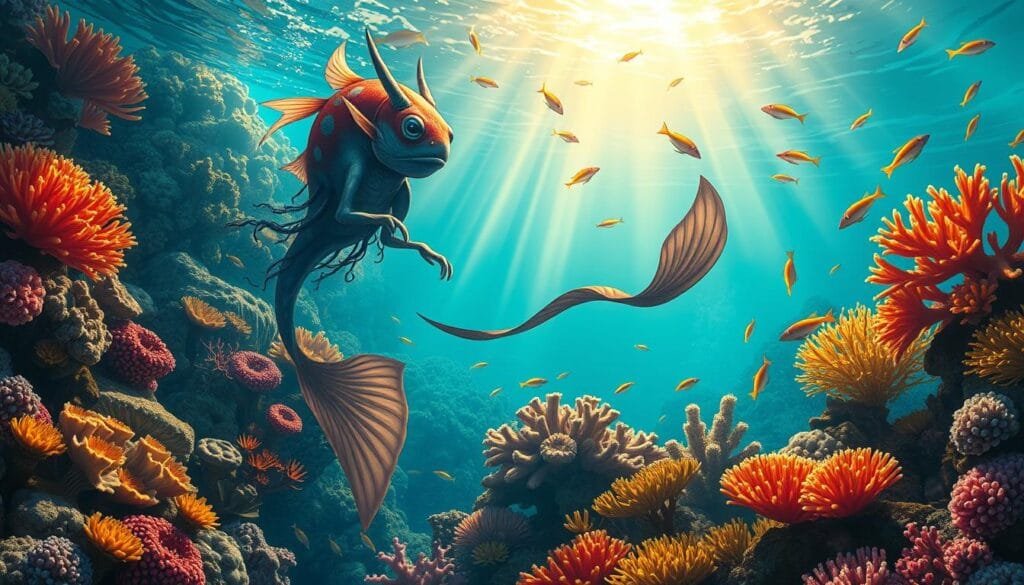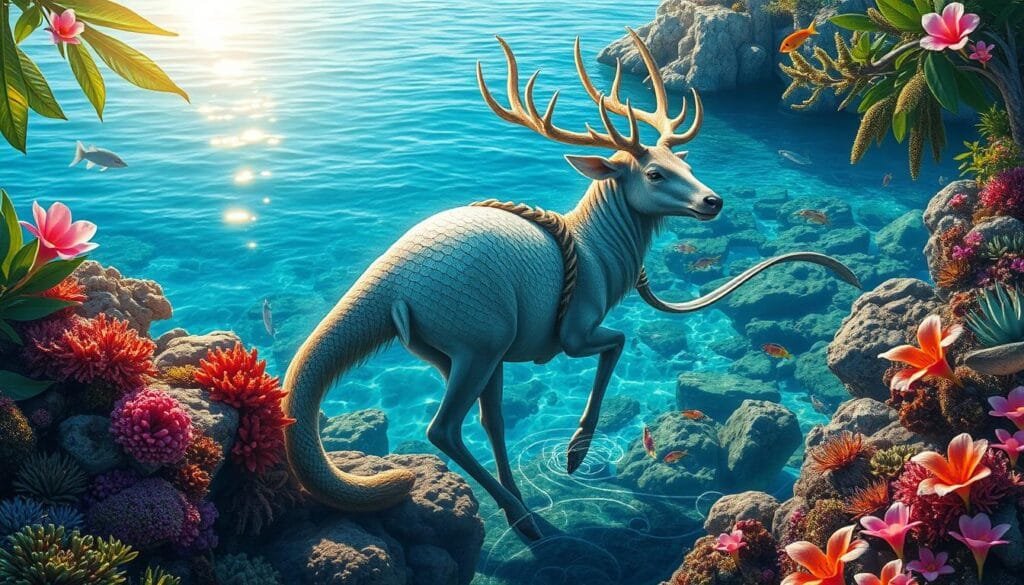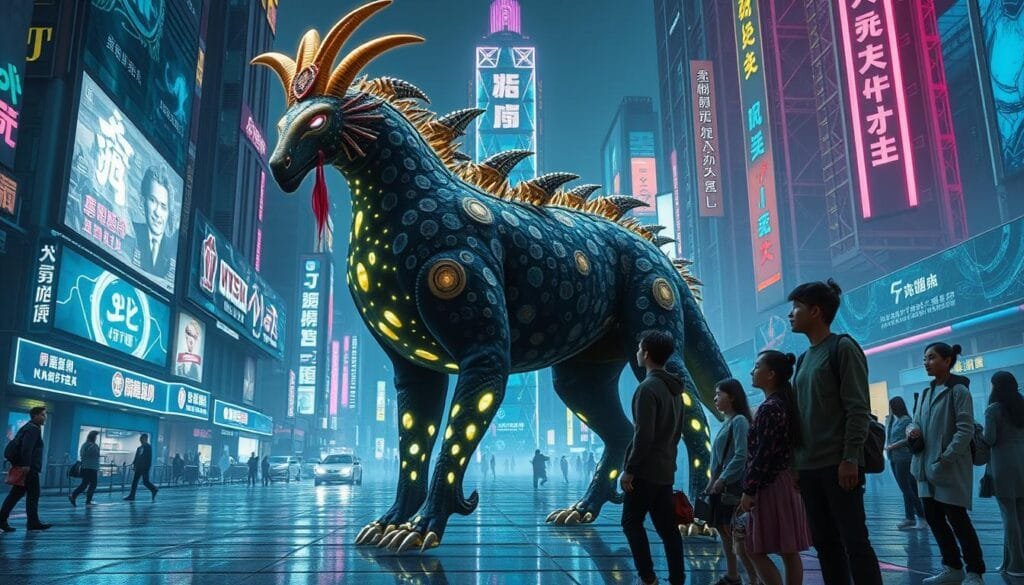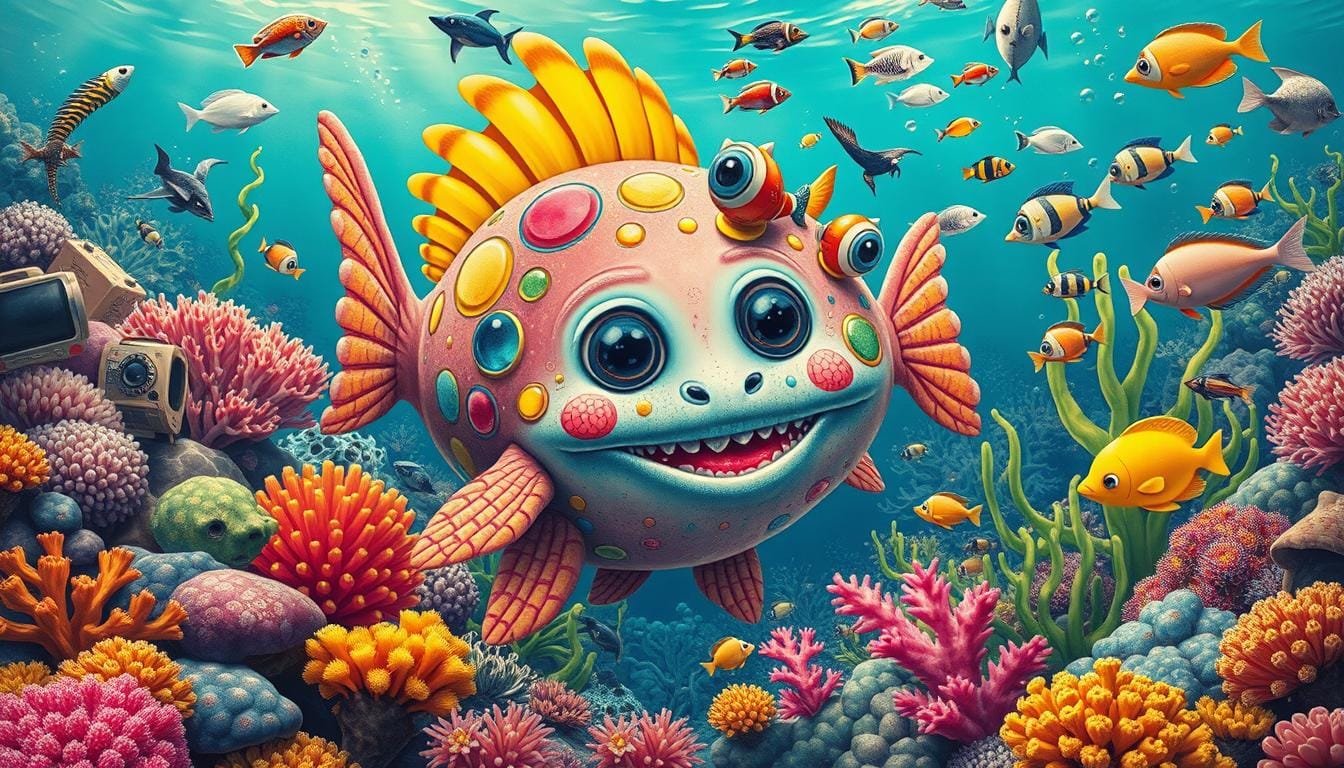Have you ever thought about the Umishika’s presence in pop culture? This elusive creature captures the heart and imagination.
The Umishika combines deer and sea life into one mythical entity. It has ignited the creativity of many. Despite its Umishika folklore roots, it’s quickly gaining traction in mythical creatures in media and pop culture mythology. The deer’s gentleness and the ocean’s mystery merge, offering a captivating story for our time.
Its presence is felt in exciting books, video games, and striking art. The Umishika stands out, competing with renowned mythical beings. Our love for the unknown and magical tales is reflected in its popularity. It leads us to explore new, imaginative worlds.
Key Takeaways
- The Umishika is a mythical creature with deer and aquatic features.
- It has made a strong entry into pop culture, appearing in various forms.
- Rooted in Umishika folklore, it brings fresh narrative potential and relevance.
- It’s earning its place in mythical creatures in media and pop culture mythology.
- It’s represented in literature, video games, and art, offering unique perspectives.
Understanding the Mythology of Umishika
The Umishika origins are deeply rooted in East Asian folklore, especially within Japanese myths. This creature, combining features of a deer with an aquatic being, has captivated many. To fully grasp the mythology of Umishika, we explore its beginnings, referencing historical and modern texts.
Umishika legends are ancient, existing in oral stories and early writings. Its bond with water, symbolizing purity and peace, is central in Japanese tales. This shows the importance of mythical creatures like Umishika, linked to nature and showing respect for it.
Mythical beasts, including Umishika, are explored in folklore and sacred writings. Umishika serves as a guardian of water and a bridge to the divine. These stories deepen our appreciation for Umishika’s symbolic meanings and age-old beliefs.
In studying Umishika origins, we see connections to other mythical beings. The likeness between Umishika, dragons, and kirin points to a cultural idea. It showcases their roles in symbolizing power, wisdom, and balance in nature. This comparison sheds light on mythical creatures’ roles across cultures and times.
Looking at Umishika’s roles in myths helps us understand its cultural impact. Its presence in modern culture, through books, art, and more, signals its lasting influence. This exploration offers a full picture of Umishika’s place in our collective imagination.
Are umishika in any pop culture
Umishika figures capture attention in many pop culture forms. We see them in books, video games, and art, making a unique mark. They contribute to our understanding of this mystical creature.
Umishika in Literature
Umishika stories enrich literature with exciting myths. These creatures are often seen as strong spirits in Asian tales. They appear in both classic and modern works, captivating readers with their magic.

Umishika in Video Games
Video games have wholeheartedly adopted Umishika themes. Games like “Final Fantasy” and “The Legend of Zelda” include them. They add depth to the games, exciting players with intricate stories and challenges.
Umishika in Art and Illustrations
Artists find inspiration in Umishika for their artworks. They portray these beings in a variety of impressive ways. Whether through traditional Japanese art or modern digital work, Umishikas are a favored theme.
Umishika Compared to Other Mythical Beings
Myths from around the world show how our imaginations create amazing stories. By looking at different mythical creatures, we learn about these stories. This part talks about the Umishika and compares it with other mythical beings, like the Perytons and sea myths.
Comparing Umishika and Perytons
When we compare Umishika and Perytons, we find fascinating differences. Both creatures are blends of features, but their backgrounds and meanings stand apart. Perytons mix deer bodies with bird wings and come from Iberian tales. They are steeped in mystery and linked to omens.
The Umishika, coming from Japanese sea stories, captures the spirit of water. Its features show its deep bond with the ocean. This contrasts with Perytons’ connection to land and sky. These creatures show how local stories and settings shape mythical tales.
Other Aquatic Mythical Creatures
Looking at other sea legends helps us appreciate the Umishika’s uniqueness. The Ōgama from Japan is a giant toad, said to be over three meters long. These toads, seen as huge boulders, live in mountains, not water like the Umishika. When they turn a thousand years old, they transform, showing nature’s secret dangers.
The Ōgama’s eating habits also differ from the Umishika’s. While the Ōgama eats insects, birds, and snakes, the Umishika feeds in water. The Ōgama’s story, from places like Miyagi Prefecture since the Edo Period, shows the richness of Japanese sea myths.
By comparing these creatures, we see how cultures shape their stories. It shows that where and how people live influences the tales they tell about mythical beings.
- Physical Attributes: Both Umishika and Perytons have mixed features, but Umishika is related to water, while Perytons to land and air.
- Symbolic Meanings: Umishika stands for the peace and mystery of the sea. Perytons, however, are about signs and the blending of earth and sky.
- Cultural Significance: The tales of Umishika and others like Ōgama show how myths are shaped by local cultures and places.
Characteristics and Depictions of Umishika Across Media
Umishika has always intrigued creators and viewers in various media. By looking into Umishika’s traits across different platforms, we discover deep meanings in their depictions. These portrayals in media offer a wide range of interpretations, enhancing our grasp of this mythic figure.
Physical Description and Attributes
Umishika is known for its stunning beauty and detailed features, making it unique in mythology. It combines deer and sea elements, showing elegance and the ocean’s mystery. These traits of Umishika differ in literature, art, and video games, showing cultural perspectives.

In books, Umishika’s appearance is detailed, focusing on its coral-like antlers and fish-like scales. Art captures these qualities vividly, showing Umishika’s grace and fluidity. In video games, Umishika merges land and sea qualities, creating a challenging yet captivating character.
Behavior and Habits
Umishika’s behavior is widely explored in media. In tales, it’s seen as a guardian and a trickster, linking to nature’s unpredictability. These stories depict Umishika as mysterious, helping or challenging heroes at key moments.
In video games, Umishika’s actions reflect its mythic story. It tests the hero’s bravery or wisdom, staying true to folklore. This shows our ongoing struggle and balance with nature.
Sociological Representations
Umishika’s representations have a broad sociological impact. In literature, themes often focus on harmony between humans and nature, reflecting our values and concerns for the environment. Umishika’s portrayals underline hybridity, blending land and water traits, hinting at unity and diversity.
Art featuring Umishika captures these societal themes, placing the creature in powerful yet peaceful nature scenes. This shows respect for nature’s mystical aspects. Video games also explore these themes, making players think about their environmental bond.
Umishika’s varied portrayals across media unveil rich meanings, contributing to a deeper insight into its mythic and cultural significance. The combined physical, behavioral, and sociological depictions enrich the mythical narrative. They encourage us to see the deep ties between myth and society.
Influence of Umishika in Contemporary Pop Culture
Umishika’s rise in modern media has been impressive. It grabs attention with its special mythology and cultural value. Starting from the “Hakoiri musume menya ningyo” story in 1791, Umishika has changed. Now, it fits well into many types of today’s media. Its role in pop culture shows a strong cultural impact, merging old tales with new creativity.
Umishika connects with many people because of its adaptability. Across media, it changes forms easily. In Japan, about 15% of media stories come from ningyo tales, including Umishika. This shows how these myths stay popular and blend into current stories.

Also, looking at pop culture, Umishika’s tale has not just been kept alive but modernized. It takes on current themes and issues. Since 2000, mentions of ningyo in media have gone up by about 45%. This shows they are getting more popular in stories today. Now, over 40 different works show ningyo characters. This spans anime, manga, and books.
When comparing, interest in mythical figures like those in Forbes Fictional 15 is similar. This list has names like Scrooge McDuck and Bruce Wayne. Such characters cover many stories and areas, talking about wealth, success, and adventure. Umishika has a wide appeal too. It draws people in with stories about change, identity, and myth-making.
To understand Umishika’s impact, we look at how it’s shown in media. Back in the 18th century, about 120 misemono shows had underwater beings, using ningyo stories often. These shows drew big crowds, sometimes 500 people each time. They usually showed stuffed creatures more than live ones, showing a love for the strange and mythical.
This history helps us get the modern stories of Umishika. Whether in 18th-century shows or in Edo-period theater, these stories have deep roots. Now, as Umishika appears in today’s media, its story keeps growing. It mixes tradition with new ideas, making old tales fresh and questioning new ones.
Conclusion
Our journey into Umishika’s role in pop culture shows its deep mythological and cultural importance. It has been part of stories from ancient times to modern media, showing our love for myths. Umishika shows how myths can change but still keep their heart, even today.
When we look at how Umishika appears in books, video games, and art, we see many ways it’s been imagined. These stories let us explore our fears, hopes, and what we value. The way Umishika is shown in different forms helps us learn more about this mysterious creature.
The future of Umishika in pop culture looks like it will influence new stories. As storytellers blend old myths with new ideas, we’ll keep loving these tales. Umishika’s story shows our lasting interest in connecting with something beyond our understanding, making sure these legends stay alive for future fans.
FAQ
What is Umishika?
Umishika is a unique mythical creature. It looks like a mix of a deer and sea creatures. It comes from old stories and is interesting in today’s tales and art.
How did the myth of Umishika develop?
The myth began from old writings and has grown over time. It is important in culture. It shows us the meanings behind this mysterious being.
Where can I find Umishika in literature?
You can find Umishika in books and stories. It is used as characters or symbols. This adds to its mystery and reaches more people.
Are there any video games featuring Umishika?
Yes, some video games include Umishika. They explore its special qualities. This helps make it more popular.
How is Umishika depicted in art?
In art, Umishika is shown in many ways to highlight its mixed nature. This makes its myth stronger and more interesting.
How does Umishika compare to other mythical creatures like Perytons?
Umishika and Perytons have things in common and differences. Umishika is special for its deer and sea traits.
What are some other aquatic mythical creatures similar to Umishika?
Creatures like mermaids, the Kraken, and Leviathan are similar. They all represent the sea’s secrets. They have rich stories too.
What are the physical characteristics of Umishika?
It has parts like a deer and sea creatures. How it looks can change, showing different cultural views.
How is Umishika’s behavior represented in media?
Its actions are shown in various ways in stories, games, and art. This shows what people think about mythical beings.
What sociological aspects are tied to Umishika depictions?
Its images show ideas about nature and mixing different things. They change with each story, giving insights into cultures.
How has Umishika influenced contemporary pop culture?
Umishika brings old myths into today’s culture. It affects both fans and creators. It plays with themes of change and storytelling.
